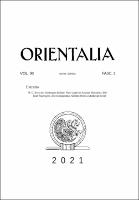Please use this identifier to cite or link to this item:
https://hdl.handle.net/20.500.12202/7816| Title: | Hydrogen Sulfide: New Light on Ancient Malodors, Biblical Toponyms, and Comparative Semitic from a Medieval Scroll |
| Authors: | Steiner, Richard |
| Keywords: | post-talmudic Hebrew Hydrogen Sulfide biblical toponyms Reuel Cairo Geniza |
| Issue Date: | 2021 |
| Publisher: | Pontificium Institutum Biblicum |
| Citation: | Steiner, Richard. (2021), Hydrogen Sulfide: New Light on Ancient Malodors, Biblical Toponyms, and Comparative Semitic from a Medieval Scroll, Orientalia, Nova Series, 90(2), 274-288.Pontificium Institutum Biblicum |
| Series/Report no.: | Orientalia;90(2) |
| Abstract: | It has always been assumed that there is no need for students of ancient Hebrew—let alone students of Proto-Canaanite—to concern themselves with post-talmudic Hebrew1. That assumption, however, is shown to be incorrect by a remarkable Hebrew scroll from Byzantium dated to ca. 1000. The scroll is one of two rotuli from the Cairo Genizah containing a commentary on Ezekiel and Minor Prophets, written in Hebrew with Judeo-Greek glosses. The commentary is attributed in a colophon to a Byzantine Jew named Reuel....(From Introduction) ¶The toponym מיֵדְבאָ , like מהדבה in the Mesha inscription, is derived from a phrase meaning “waters of vigor”. It seems to allude to the therapeutic value of the hot sulfur springs east of the Dead Sea, rather than their stench. The belief that these springs had the power to restore vigor to the old and infirm led the physicians of Herod the Great to bring him to the spa at Callirrhoe during his final illness. (from Conclusion) |
| Description: | Scholarly article / 2-year embargo |
| URI: | https://doi.org/10.32060/Orientalia.2.2021.274-288 https://hdl.handle.net/20.500.12202/7816 |
| ISSN: | 0030-5367 |
| Appears in Collections: | Bernard Revel Graduate School of Jewish Studies (BRGS): Faculty Publications |
Files in This Item:
| File | Description | Size | Format | |
|---|---|---|---|---|
| Steiner Hydrogen Sulfide Orientalia 90-2 (2021) 274-288 2yr embargo O.pdf | 562.99 kB | Adobe PDF |  View/Open |
This item is licensed under a Creative Commons License

